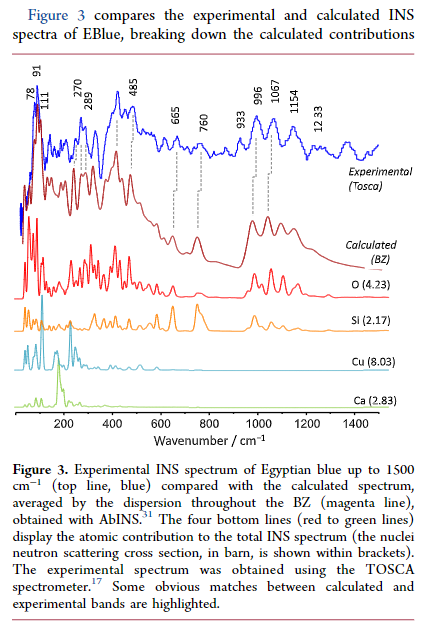Egyptian Blue was the 1st synthetic pigment, dating back to around 3000 BC. In Ancient Egyptian times, blue was considered a colour of royalty and wealth, and was used on pharaohs tombs and sculptures. However, the blue pigment lapis lazuli was expensive and hard to come by. Egyptian blue provided a solution to this problem, resulting in blue pigment being more readily available and used more frequently in paintings and pottery. The pigment was created from sand, limestone and copper containing minerals, which was heated to around 815 degrees Celsius in a furnace.
The pigment decreased in use after the Roman period but has been rediscovered in the 21st century. Egyptian Blue has the potential to be used in a wide range of fields from forensic science to creating lasers and telecommunication devices. The pigment possesses key qualities which allow this, such as being non-toxic, highly stable and having near-infrared luminescence. There is also a low cost to produce this pigment, with no cost to maintain, thanks to its durability.
 Researchers from the Universidade de Aveiro collaborated with Principal Instrument Scientist Svemir Rudic at ISIS to investigate the structure of the pigment Egyptian Blue, to further understand the structure-property relationship. Previous research has demonstrated that Egyptian Blue is a silicate tetrahedron with either a 4 or 8- membered ring arrangement with layers of either silicate or copper. However, this new research delved deeper into the crystalline and electronic structure.
Researchers from the Universidade de Aveiro collaborated with Principal Instrument Scientist Svemir Rudic at ISIS to investigate the structure of the pigment Egyptian Blue, to further understand the structure-property relationship. Previous research has demonstrated that Egyptian Blue is a silicate tetrahedron with either a 4 or 8- membered ring arrangement with layers of either silicate or copper. However, this new research delved deeper into the crystalline and electronic structure.
In-depth analysis of Egyptian Blue used various vibrational spectroscopies, including Inelastic neutron scattering (INS), Raman and Infrared. Inelastic neutron scattering (INS) spectroscopy was conducted at ISIS via our TOSCA instrument. INS spectroscopy provides the structural dynamics of Egyptian Blue that cannot be obtained via other spectroscopy techniques and presents a unique understanding of the pigments structure. Further methods were employed to understand the electron structure further: the Density function theory, X-ray diffraction and UV-vis diffuse reflectance.
 This research solidifies knowledge of the crystalline and electronic structures of Egyptian Blue. It is the first time that the Debye temperature and heat capacity of Egyptian Blue has been reported which is fundamental to understanding how Egyptian Blue would function as part of a device and is responsible for discovering the pigment’s electronic properties.
This research solidifies knowledge of the crystalline and electronic structures of Egyptian Blue. It is the first time that the Debye temperature and heat capacity of Egyptian Blue has been reported which is fundamental to understanding how Egyptian Blue would function as part of a device and is responsible for discovering the pigment’s electronic properties.
Undoubtably, Egyptian Blue could have a key a role in the future of our technology and once again be a widely available and useful pigment as it was back in the Ancient Egyptian times.
For more information on this research see the full paper here: Shedding Light on Cuprorivaite, the Egyptian Blue Pigment: Joining Neutrons and Photons for a Computational Spectroscopy Study (acs.org)
